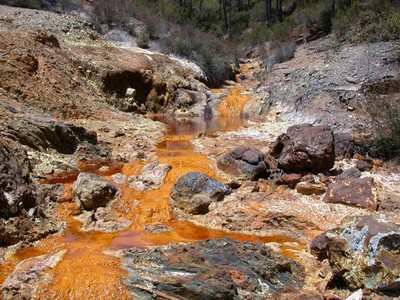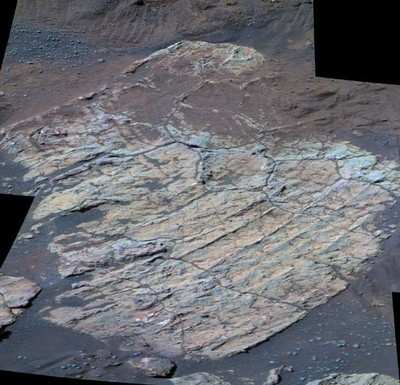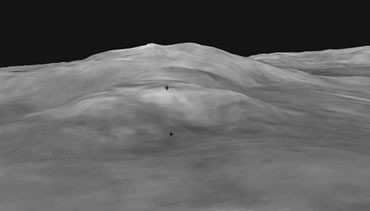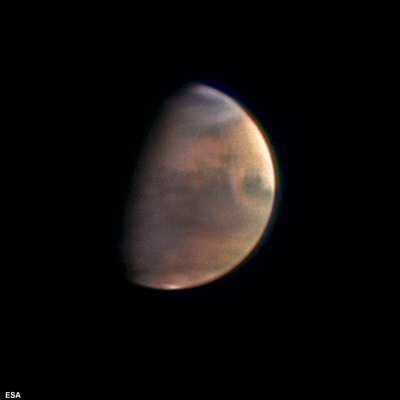NOVA Special Looks At The Roving Odyssey On The Red Planet
By ANN Senior Editor Pete Combs
A year after landing on Mars, the twin rovers Spirit and
Opportunity continue their quest to confirm the existence of water
-- and perhaps life -- on a planet that now appears so very
sterile.

"You need to have the stuff from which life is made," said
Cornell University's Steve Squyres, leader of the rover science
team. "The one thing we know that you have to have for life as we
know it on Earth is liquid water. Mars today is a cold, very dry
and desolate place. Yet, there are these tantalizing hints from the
pictures [taken by the Mars Global Surveyor orbiting Mars] that it
was once wetter."
 It's been a good year on Mars. So
far, Squyres and his team at NASA's Jet Propulsion Lab in Pasadena,
CA, has been able to say with authority that there once was water
on Mars. That's the subject of a NOVA documentary about the rover's
first year on Mars which airs Tuesday night at 2000 EST on PBS.
It's been a good year on Mars. So
far, Squyres and his team at NASA's Jet Propulsion Lab in Pasadena,
CA, has been able to say with authority that there once was water
on Mars. That's the subject of a NOVA documentary about the rover's
first year on Mars which airs Tuesday night at 2000 EST on PBS.
"I think the real striking result is from the Opportunity
rover," Squyres told ANN. Opportunity landed in the Meridiani
Planum, where scientists had seen orbital pictures indicating the
possible presence of water.
"What we found there was evidence that long ago, there was a
salty sea. Now it was probably very shallow and it was probably
only there some of the time. You shouldn't be thinking 'ocean.' You
should be thinking 'salt flats' and that kind of thing," Squyres
said.
But where there's water, there's always the chance there's life.
But Sqyres said you probably wouldn't have wanted to drink it. "It
was muddy, it was salty -- very salty. It was probably acid. We've
got pretty powerful clues now saying the water was [full of]
sulfuric acid. It was kind of nasty stuff." And yet, he said, "It's
the kind of environment that would have been suitable for some
kinds of life."

Sqyres suggests the water on Meridiani Planum might have been
like the water in the Rio Tinto in Spain (above). There, "the water
is very, very acid," he said. "It's dissolved iron out of the rocks
and there's so much iron in the water that it's a ruby red color.
So I've got this picture in my mind of Meridiani long ago... of a
red sea under a pink Martian sky. It could have been a very unusual
looking place."
Both Spirit and Opportunity have long outlived their warranties.
Both were designed to last about 90 days. It's a year later and,
like the Energizer Bunny, they're still going. But that presents
the JPL team with a whole new set of problems, said Squyres.
"There's always something new on the horizon," he told ANN.
"There's always something new on the horizon. We're far from
running out of things to do on Mars.... We've worked very hard to
find ways of operating these vehicles that will enable us to keep
doing it for a very long period of time."

The Year Ahead On Mars
In the year ahead, Squyres said Spirit will continue to explore
the Columbia Hills, where, after a long, torturous climb, the rover
has found very intriguing signs that bedrock exposed by eons of
wind erosion were originally formed by water.
"We're piecing that story together outcrop by outcrop, working
out way up the hills. This is a big range of hills -- it's 120
meters high and we're only about 20-25 meters up into the hills so
far, so there's a lot of mountaineering ahead of us and a lot of
new stuff out there."
While Spirit has become the first mountaineer on Mars,
Opportunity may soon take a long trip south. "If you go to the
south about three kilometers," Squyres said, "there's something
totally different. There's material we're calling the 'Etched
Terrain.' That's sort of a descriptive term. We think those are
rocks eroded by the wind. So we're hoping to go down there an
explore those rocks."
They would be very different from the rocks Opportunity has
already explored on the Planum. There, Squyres said, the rocks were
generally blasted apart by asteroid impacts. "It's like the rocks
have been put into a blender and it's kind of hard to read that
record. But to the south of us, we think we see rocks that have
been exposed very gently by the wind and there we think we'll find
a record that will be much easier to make sense of."

Manned Mission?
Remember that Squyres is a robot guy. For the past several
years, his life's work has centered on the robotic rover missions.
But when you ask him if his robots can replace humans, you might be
surprised at his answer.
"I think [a manned mission] is both feasible and necessary. Even
I feel the best exploration, the most successful and the most
inspiring exploration is going to ultimately be done by humans. I
feel that anybody who would point at the success of Spirit and
Opportunity as evidence that we shouldn't send humans is missing
the point completely.

"I've always viewed our robots as being advanced scouts," he
said. "They're scouting the way for humans who are going to go
there eventually."
 ANN's Daily Aero-Linx (04.30.25)
ANN's Daily Aero-Linx (04.30.25) ANN FAQ: Turn On Post Notifications
ANN FAQ: Turn On Post Notifications Classic Aero-TV: Agile Aeros Jeff Greason--Disruptive Aerospace Innovations
Classic Aero-TV: Agile Aeros Jeff Greason--Disruptive Aerospace Innovations Aero-News: Quote of the Day (04.30.25)
Aero-News: Quote of the Day (04.30.25) ANN's Daily Aero-Term (04.30.25): Expedite
ANN's Daily Aero-Term (04.30.25): Expedite







